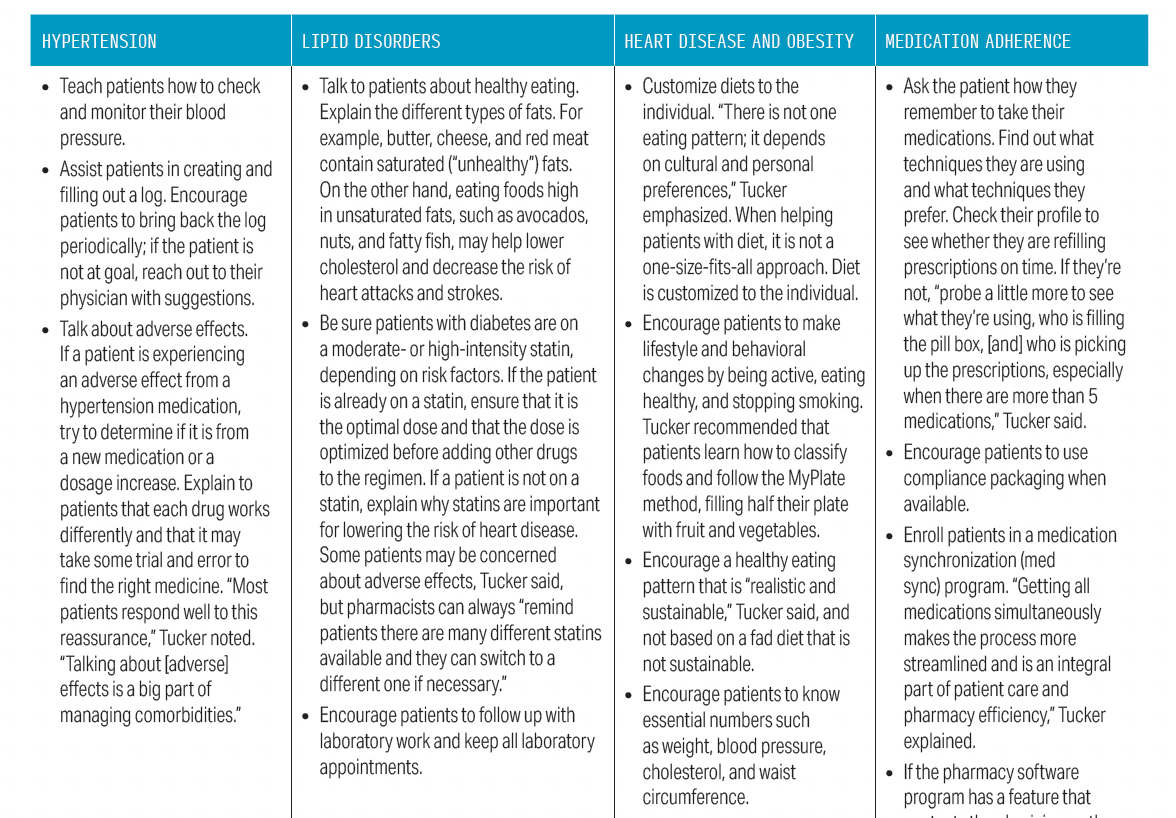
- Drug Topics September 2022
- Volume 166
- Issue 9
Tips for Managing Diabetes Comorbidities

Considering comorbidities is just as important as lowering patient HbA1c.
Common comorbidities in patients with type 2 diabetes include hypertension, lipid disorders, heart disease, and obesity.1,2 As accessible health care professionals, pharmacists are uniquely positioned to counsel and encourage patients with diabetes to manage comorbidities.
Drug Topics® spoke with Angelina Tucker, PharmD, BCGP, CDCES, the managing network facilitator of Community Pharmacy Enhanced Services Network (CPESN) Texas. She is also the clinical pharmacist for Best Value Pharmacies, an independent chain of 13 pharmacies in Texas. Tucker manages the chain’s medication therapy management services and diabetes self-management education classes. She is also a Flip the Pharmacy practice transformation coach.
Tucker noted a shift in the American Diabetes Association guidelines to focus on prescribing medications for diabetes comorbidities rather than just lowering hemoglobin A1c. “Although this has not fully transitioned into clinical practice, it is important for pharmacists to consider comorbidities that the patient is facing—for example, considering a drug with a low risk of hypoglycemia in older adults or considering a sulfonylurea when cost is an issue,” she explained.
The following tips can be implemented by chain and independent pharmacists, and Tucker encouraged all pharmacies to bill for their services. One way to start providing these services is to inquire with the state or local universities about grants to get pharmacies accredited to provide diabetes education.
Tucker offers 10 hours of education—1 hour per week for 10 weeks and periodically thereafter—focusing on a different topic each week, such as being more active, healthy coping mechanisms, and taking medications as directed. Her classes are interactive and encourage patients to share stories and tips. Each week, patients are encouraged to devise SMART goals—goals that are specific, measurable, attainable, relevant, and time-based—for the following week.
See the sidebar below for Tucker’s top tips for pharmacists to help patients with diabetes manage comorbid conditions.
Although it can be difficult to provide all these supports in a hectic pharmacy environment, “at the end of the day, your patients come first and so does protecting your license,” Tucker said. Tucker recommended using CPESN’s med sync appointment-based model to achieve med sync with more than 80% of patients, adding that this allows pharmacists to be proactive rather than reactive.
Counseling Pearls: Managing Diabetes Comorbidities
Angelina Tucker, PharmD, BCGP, CDCES shared the following:
Sulfonylureas: These drugs (glimepiride, glipizide, glyburide) are more likely to cause hypoglycemia in older adults, possibly leading to a higher risk of falls, fractures, and other complications. Talk to patients about their frequency of low blood sugar, and consider contacting the physician for an alternative medication.
Metformin: The new American Diabetes Association guidelines recommend periodic monitoring of vitamin B12 for patients on long-term metformin. Patients who experience fatigue, drowsiness, and/or weakness should consult their health care provider because these may be signs of B12 deficiency. Tucker also counsels patients about nausea, vomiting, diarrhea, and general stomach upset from metformin and reminds patients to take metformin with food.
SGLT2 inhibitors: Canagliflozin (Invokana) and empagliflozin (Jardiance) are 2 examples of SGLT2 inhibitors, which can cause urinary tract infections. Counsel patients to drink plenty of fluids and be alert to symptoms of a urinary tract infection. Patients should contact their physician if they have symptoms of burning, frequency, and urgency.
References
1. Recent top 15 comorbid conditions among patients with type 2 diabetes mellitus—a large national medical records review study. American Diabetes Association. 2006. Accessed August 15, 2022.
2. American Diabetes Association.
Articles in this issue
over 3 years ago
The Evolution of the CBD Regulatory Landscapeover 3 years ago
Women and CBD: Increased Interest, but Caution Is Warrantedover 3 years ago
Mitigating Costs of Cancer Treatment: The Role of Pharmacistsover 3 years ago
Counseling Pearls for CBDover 3 years ago
Drug Testing Challenges Emerge With CBD Product Useover 3 years ago
Waste Problem Shows COVID-19 Vaccines Aren’t Just a Dime a Dozenover 3 years ago
CBD Products: What Pharmacists Need to KnowNewsletter
Pharmacy practice is always changing. Stay ahead of the curve with the Drug Topics newsletter and get the latest drug information, industry trends, and patient care tips.












































































































































































































